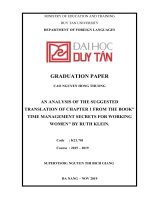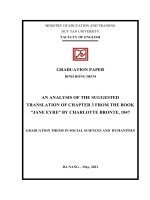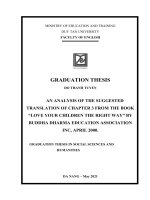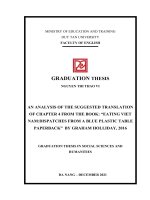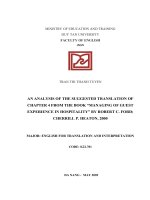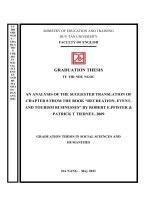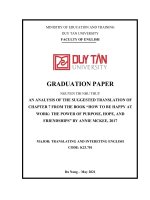AN ANALYSIS OF SUGGESTED TRANSLATION OF CHAPTER 6 ROM THE BOOK “BUSINESS AND PROFESSIONAL COMMUNICATION ” BY STEVEN a BEEBE TIMOTHY PMOTTET, 2013
Bạn đang xem bản rút gọn của tài liệu. Xem và tải ngay bản đầy đủ của tài liệu tại đây (296.34 KB, 61 trang )
MINISTRY OF EDUCATION AND TRAINING
DUY TAN UNIVERSITY
FACULTY OF ENGLISH
GRADUATION THESES
AN CANH TOAN
AN ANALYSIS OF SUGGESTED TRANSLATION OF CHAPTER 6
FROM THE BOOK “BUSINESS AND PROFESSIONAL
COMMUNICATION ”
BY STEVEN-A.-BEEBE-TIMOTHY-PMOTTET, 2013
GRADUATION THESES IN SOCIAL SCIENCES AND
HUMANITIES
DA NANG – MAY 2022
ACKNOWLEDGEMENT
Thanks to the invaluable help, advice, and encouragement of my dear
teachers, friends and family, I could finish this graduation paper with great
ease and success.
First of all, I would like to express my deepest gratitude to the all of
lectuters of Foreign Language Department .Especially teachers have directly
taught and helped me during 2 years in Duy Tan University. Thanks to strong
professional skills as well as enthusiastic teaching of teachers, I learned many
things useful. It’s help me a lot. Not only improving my skills but also
supporting for my job in future.
Nextly, I really want to send my greatest thanks to my supervisor –
Mrs. Luong Kim Thu who used her whole- heainrted guidance to me. She not
only gave me useful comments but also solved many problems that I don’t
understand to complete the project.
Finally yet importantly, I’m also indebted to my friends especially my
family who have always been with me, support and encourage me a lot. They
are one of motivations helping me on completion of this graduation paper.
Forthcoming, I will have to pass the final test to be able to graduate
after 2 years of study. I hope that all will be well and I will get what I want.
I hopefulness everyone will achieve much success and good health.
Sincerely!
STATEMENT OF AUTHORSHIP
Except where reference is made in the text of the thesis, this thesis
contains no material published elsewhere or extracted in the whole or part
from a thesis by which have qualified for or been awarded another degree of
diploma.
No other person’s work has been used without due acknowledgement in
the thesis. This thesis has not been submitted for award of any degree or
diploma in any other tertiary institution.
Da Nang, May 1st 2022
ABBREVIATIONS
TL : Target language
SL : Source language
S
: Subject
V
: Verb
O
: Object
TABLE OF CONTENT
ACKNOWLEDGEMENT.........................................................................................i
STATEMENT OF AUTHORSHIP............................................................................ii
ABBREVIATIONS.................................................................................................iii
TABLE OF CONTENTS.........................................................................................iv
CHAPTER 1. INTRODUCTION...........................................................................1
1.1 Rationale.............................................................................................................1
1.2 Aims and Objectives..........................................................................................2
1.2.1 Aims.................................................................................................................2
1.2.2 Objectives........................................................................................................2
1.3. The scope of the study........................................................................................2
1.3.1.The text features...............................................................................................3
1.3.2.The text length.................................................................................................3
1.3.3.The text organization........................................................................................3
CHAPTER 2. THEORETICAL BACKGROUND....................................................4
2.1 Definitions..........................................................................................................4
2.2. Types of categories.............................................................................................4
2.2.1 : Full and Partial Translation............................................................................4
2.2.2 Total and restricted translation........................................................................5
2.2.3 Phonological translation..................................................................................5
2.3 Methods, principles and rules of translation........................................................6
2.3.1 Methods of translation......................................................................................6
2.3.1.1 Word-for-word translation.............................................................................6
2.3.1.2. Literal translation........................................................................................6
2.3.1.3 Faithful translation.......................................................................................6
2.3.1.4. Semantic Translation....................................................................................6
2.3.1.5. Adaptation translation..................................................................................7
2.3.1.6. Free translation............................................................................................7
2.3.1.7. Idiomatic translation....................................................................................7
2.3.1.8. Communicative translation...........................................................................8
2.3.2 Principles of translation....................................................................................8
2.3.2.1 Meaning........................................................................................................8
2.3.2.2 Form..............................................................................................................8
2.3.2.3 Register.........................................................................................................9
2.3.4 Source language influence...............................................................................9
2.3.4.1 Idiom.............................................................................................................9
2.3.4.2. Style and clarity...........................................................................................9
3.3 Rules of translation...........................................................................................10
3.3.1. The rule of proximity....................................................................................10
3.3.2. The rule of parallelism..................................................................................10
CHAPTER 3. SUGGESTED TRANSLATION......................................................11
CHAPTER 4: ANALYSIS......................................................................................37
4.1. VOCABULARY..............................................................................................37
4.1.1. Word and phrase with no approriate meaning in dictionary..........................37
3.1.2. Phrases and Phrasal Verb...............................................................................42
4.2. STRUCTURE..................................................................................................43
4.2.1 Simple Sentence.............................................................................................43
4.2.2. Compound Sentences....................................................................................44
4.2.3. Complex Sentences and Reduced Relative Clauses......................................45
4.2.3. Sentences in Passive Voice............................................................................46
4.2.4 Relative Clause..............................................................................................47
4.2.5. Compound – complex sentences...................................................................48
CHAPTER 5. DIFFICULTIES AND SOLUTIONS...............................................49
5.1. Difficulties.......................................................................................................49
5.2. Solutions..........................................................................................................51
CHAPTER 6. CONCLUSION AND SUGGESTIONS...........................................52
1.Conclusion..........................................................................................................52
2.Suggestions.........................................................................................................53
REFERENCES.......................................................................................................54
CHAPTER 1. INTRODUCTION
1.1 Rationale
Everyone has attended or will attend a job interview in there life time,
which is considered to be a very stressful process for most. However, by
being prepared for an interview it can calm nervous and help a person land the
job of their dreams. The overall goal of an interview is to convince the
recruiter that you’re the best person for the job. In order to this, the
interviewee must sell his or her skills, knowledge, and experience in a
professional manner to the employer. The company will also be looking for
people that are motivated and bring a positive personality to the organization.
As we all know interview is a social process where two or more persons will
involves in verbal interactions. That two or more person were one is
Interviewee or candidate and other set of person were interviewer. While
conducting an interview, interviewer will get a chance to learn about the inner
traits and qualities of the candidate. The candidate will get very short span of
time to exhibit his attitude, skills, and the knowledge which they acquired
during their long academic years. Knowing the importance of Interview skills,
I decided to do the thesis on this topic.
Besides being passionate about foreign languages, I found myself also
interested in business. Beside be a student majoring in English. Especially,
English translation and Interpretation I recognize that I need develop myself a
lot. Besides, I need try my best to prove myself so that everyone can see me
the best way and about the field that I'm studying.
Moreover, the demand for translation is increasing, so the requirements
in this field are very high and it is difficult for students who are about to
graduate as me. So, the reason why I choose this book is a part it can help me
orientation for myself but probably for many other students like me.
1
1.2 Aims and Objectives
1.2.1 Aims
This graduation paper has reflected my own ability in the past two
years. During those years, I received valuable support, help, and
encouragement of my supervisor, my teachers and friends at Duy Tan
University.
It helps the translator with an overview of the translation process as
analytics and translations skills. Hence, it helps me avoid a number of my
faults in translation process.
In details, my Graduation Paper aims at:
- To upgrade my translating skill.
- Collecting and presenting basic English terms in Business Providing
their Vietnamese equivalents or expressions.
I hope that this graduation paper can provide readers with a lot
Business knowledge, and the information from the text also effectively help
translator in this field.
1.2.2 Objectives
The translator can intensively understand translation theory in order to
apply it to translation process. Furthermore, the translator can also logically
analyze sentence structure and vocabulary in a better way.
1.3. The scope of the study
Due to time limitation, this paper only focuses on some first parts of
the chapter 7 with 4,500 words.
The paper will also show and analyze the difficulties with which I met
when translating, for example Business
term, the way to use English
grammar and syntactic structures as well as word’s semantics in the field of
Business.
2
1.3.1. The text features
The mission of this book is to provide students with a basic
understanding of the many different aspects in Business.
1.3.2. The text length
This book includes 4 parts, each part is divided into chapters. The total
number of pages for the book is 456 pages. But the rules only translates 4,500
words so, I will translation chapters 7 with 4,500 words in length. The name
of chapters 8 are respectively “Interview Type”.
1.3.3. The text organization
More than 14 chapters are analytical, Every chapter of the text is
infused with discussions related to principles and skills for leadership.
Although most business and professional communication textbooks include a
discussion of leadership, we have woven discussion and application of
leadership into each chapter, from the opening scenarios that profile
successful leaders to tips and guidelines for how to communicate and lead
effectively in boxes and text discussions throughout. Moreover, expands our
application of communication skills to business and professional settings,
from the chapter opening narratives and “Leading Questions” to practical tips
and guidelines to the skill-building activities at the end of chapters. In
business and professional contexts there are four primary communication skill
sets that lead to success: relating, collaborating, presenting, and writing. We
offer specific recommendations on how to develop these competencies,
drawing upon the latest communication research and wisdom from seasoned
leaders.
3
CHAPTER 2. THEORETICAL BACKGROUND
2.1 Definitions
English is the most widely used "second" and "learning" language in the world
used for international communication in various fields like aviation, business, internet,
science and technology. Accordingly translation and interpretation is an essential and
also difficult major which creates many job opportunities for graduate students.
Translation has been defined in many ways:
Translation is the replacement of textual material in one language (source
language) by equivalent textual material in another language (target language).
(Catford – 1965)
Translation is the process of finding a target language (TL) equivalent
from a source language (SL) utterance. (Pinhhuck – 1977:38)
Translation is the process of changing something that is written or spoken
into another language. (Advanced Oxford Dictionary)
Translation is the act of transferring through which the content of a text is
transferred from the SL into the TL. (Foster - 1958:1)
Translation is a craft consisting in the attempt to replace a written message
and/or statements in one language by the same message and/or statement in another
language. (Newmark, 1981:7)
Translation is an act of communication which attempts to relay, across
cultural and linguistic boundaries, another act of communication. (Hatim and
Mason - 1997:1)
These concepts support the idea that translation is a complex process which
requires also theoretical knowledge as well as practical experiences.
2.2. Types of categories
2.2.1 : Full and Partial Translation
Translation devided into two types : full and partial
(i) According to JC Carford, full translation is every part of source language is
replaced by target language text material through translation.
Example :
His ability to see this was imagination that enabled him to build and operate
the Great Northern Railway System.
4
Suggested version : Sự thông minh của anh ta cho thấy rằng trí tưởng tượng
cho phép anh ta xây dựng và vận hành Hệ thống Đường sắt lớn phía Bắc.
(ii) According to JC Carford, partial translation is some parts of source
language text are left untranslated and or incorporated in the target language text.
Example :
“Áo dài” là một trong những trang phục truyền thống của phụ nữ Việt Nam
Suggested version : “ Ao dai” is one of the traditional costumes of
Vietnamese women.
2.2.2 Total and restricted translation
(i) Total translation is replacement of SL grammar and lexis by equivalent TL
grammar and lexis with consequential replacement of SL phonology/graphology by
(non-equivalent) TL phonology/graphology.
Example :
These greater opportunities of today call for greater efficiency than was
acceptable 25 years ago
Suggested version : Những cơ hội lớn hơn của ngày hơm nay địi hỏi năng lực
ở mức cao hơn so với 25 năm trước
(ii)Restricted translation is replacement of SL textual material by equivalent
TL textual material, at only one level. In restricted translation, translation is
performed only at the phonological, Graphological, grammatical or lexical level.
Example :
Time flies like an arrow
Suggested version : thời gian thấm thoát thoi đưa
2.2.3 Phonological translation
Phonological translation means translating a word from the Sources
Language into the closest sound in the Target Language.
Example :
Piano – pi-a-no
Guitar – ghi-ta
2.3 Methods, principles and rules of translation
5
2.3.1 Methods of translation
2.3.1.1 Word-for-word translation
The source language is translated word by word. This is often demonstrated as
interlinear translation, with the target language immediately below the source
language words. The source language word-order is preserved and the words
translated singly by their most common meanings, out of context.
Example:
Sell brothers far, buy neighbors near.
Bán anh em xa, mua láng giềng gần.
2.3.1.2. Literal translation
The grammatical structure of the source language to be transferred to the
nearest structure of the target language but the words are translated most
conventional sense, integral context but still sticking literally.
Example:
She is deaf to all his advice.
Cô ta lờ đi tất cả những lời khuyên của anh ta.
2.3.1.3 Faithful translation
A faithful translation attempts to reproduce the precise contextual meaning of
the original meaning within the constraints of the target language grammatical
structures. It “transfers” cultural words and preserves the degree of grammatical and
lexical “abnormality” in the translation. It attempts to be completely faithful to
intentions and the text realization of the source language writer.
Example:
He is as fast as a kangaro.
Anh ta nhanh như một con kang-gu-ru.
2.3.1.4. Semantic Translation
Semantic translation differs “faithful translation” only in as far as it must take
more account of the aesthetic value (that is, the beautiful and natural sound) of the
source language text, compromising on ‘meaning’ where appropriate so that no
assonance, word-play or repetition jars in the finished version. Further, it may
translate less important cultural words by culturally neutral third or functional terms
but not by cultural equivalents. The distinction between ‘faithful’ and ‘semantic’
translation is that the first is uncompromising and dogmatic, while the second is
more flexible, admits the creative exception to 100% fidelity and allows for the
translator’s intuitive empathy with the original.
Example:
6
We hope you will enjoy your staying with us
Chúng tơi hy vọng ngài sẽ có mợt kỳ nghỉ tuyệt vời tại khách sạn này.
2.3.1.5. Adaptation translation
This is the “freest” form of translation. It is used mainly for plays and poetry.
The themes, characters, plots are usually preserved, the source language culture is
converted to the target language culture and the text is rewritten
Example:
Thà một phút huy hồng rồi chợt tắt
Cịn hơn buồn le lói suốt trăm năm
(Xuân Diệu)
It would rather the victorious brightness
In an only moment the centenary twinkle
2.3.1.6. Free translation
The maner in which the translator translate secape binding of the original form
original language, translation language used to interpret the meaning of the original.
Thus the translation tends longer than the original.
Example:
Business is business.
Cơng việc là cơng việc, tình cảm là tình cảm, khơng lẫn lợn được.
2.3.1.7. Idiomatic translation
This method reproduces the “message” of the original again but tends to
distort the nuances of meaning by preferring colloquialisms and idioms where these
do not exist in the original.
Example:
When in Rome, do as the Rome do.
Nhập gia tùy tục.
2.3.1.8. Communicative translation
Communicative translation attempts to render the exact contextual meaning of
the original in such a way that both content and language are readily acceptable and
comprehensible to the readership.
Example:
Get the raincoat or you’ll get a cold.
Mặc áo mưa vào không là bị cảm đó.
2.3.2 Principles of translation
2.3.2.1 Meaning
The translation should reflect accurately the meaning of the original text.
Nothing should be arbitrarily added or removed, though occasionally part of the
meaning can be “transposed”. The following questions will be very helpful.
7
a. Is the meaning of the original text clear?
b. If not, where does the uncertainty lie?
c. Are any words loaded, that is, are there any underlying implications?
d. Is the dictionary meaning of a particular word the most suitable one?
e. Does anything in the translation sound unnatural or forced?
Example:
Suddenly Jordan, with deep tenderness, ran his hand very slowly over head.
(The Feather Pillow, Horacio Quiroga)
Đột nhiên, rất nhẹ nhàng Jordan từ từ vịng tay qua đầu cơ.
2.3.2.2 Form
The ordering of words and ideas in the translation should match the original as
closely as possible.This is particular in the form and order of words. This is also
probably essential in translating legal documents, guarantees, contracts, etc). But
differences in language structure often require changes in the form and order of
words.
Example:
No sooner had he left the office than the phone rang.
Ngay khi anh ta vừa ra khỏi cơ quan thì điện thoại reo.
2.3.2.3 Register
Languages often differ greatly in their level of formality in a specific context.
To resolve these differences, the translator must distinguish between formal or fixed
expressions and personal expressions in which the writer or speaker sets the tone.
Example:
Please fill in this form.
Xin vui lòng điền vào mẫu đơn này.
2.3.4 Source language influence
2.3.4.1 Idiom
Idiomatic expressions - including similes, metaphors, proverbs, sayings,
jargon, slang, colloquialisms, and phrasal verbs - are commonly hard to translate. To
solve this problem, try any of the following.
a. Keep the original word between inverted commas.
b. Keep the original expression, with a literal explanation in brackets.
c. Use a close equivalent.
d. Use a non-idiomatic or plain prose translation.
When we translate idioms we should note that “The golden rule is if the idiom
does not work in the target language, do not force it into the translation”.
Example:
Out of sight, out of mind.
Xa mặt cách lòng.
8
2.3.4.2. Style and clarity
The translator should not change the style of the original as much as
possible. Changes are likely to happen if it necessary such as, many repetitions or
mistakes in writing.
Example:
He ate, and drank, and talked, and asked during the meal.
Anh ta vừa ăn, vừa uống, vừa hỏi suốt cả bữa ăn.
3.3 Rules of translation
3.3.1. The rule of proximity
When modifying any item of language, the modifier must be placed closest to
that item even though the modifier is a single word, a phrase or clause.
As in these examples:
Only Gary hit his classmate on the nose. => Chỉ có Gary đánh bạn cậu ta vào mũi.
Gary only hit his classmate on the nose. => Gary chỉ đánh bạn cậu ta vào mũi thôi.
Gary hit his only classmate on the nose. => Gary đánh người bạn duy nhất của
cậu ta vào mũi.
3.3.2. The rule of parallelism
The speech element of the same grammatical function must be performed in
an only similar structure form.
For example: He came both in the morning and in the afternoon.
9
CHAPTER 3. SUGGESTED TRANSLATION
Paragraph
Para 1
Orginal version
Suggested translation
To prepare an information- Để chuẩn bị một cuộc phỏng vấn
gathering
interview,
the thu thập thông tin, người phỏng
interviewer needs to first be vấn trước tiên cần nhận thức
aware of his or her goal for được mục tiêu của họ cho cuộc
the interview. What type of phỏng vấn. Bạn cần loại thông
information do you need?
tin nào? Dưới đây là một số mục
Here are some possible goals tiêu có thể có của các c̣c phỏng
of
information-gathering vấn thu thập thông tin:
interviews:
Để điều tra một vấn đề hoặc một
To investigate an issue or an sự kiện. Các phóng viên báo chí
event.
Newspaper
television
reporters
and và trùn hình có trách nhiệm để
are báo cáo tin tức, bao gồm cả việc
responsible for reporting the tìm kiếm và định vị thơng tin.
news, which includes finding Những phóng viên xác định
and
locating
information. những cá nhân thích hợp và sau
Reporters identify appropriate đó hỏi họ những câu hỏi như Ai?
individuals and then ask them Gì? Ở đâu? Khi nào? Thế nào?
questions
Para 2
such
as
Who? và tại sao?
What? Where? When? How?
To conduct research to Một cuộc phỏng vấn hiệu quả
identify patterns and trends. đáp ứng ba tiêu chí:
Some
businesses
research
units
responsible
market
for
that
Nó có cấu trúc. C̣c phỏng vấn
are là mợt c̣c trị chuyện có kế
conducting hoạch bao gồm phần giới thiệu,
research.
professionals
have
make
These phần thân và một phần kết luận.
phone
Đó là mục tiêu theo định hướng.
calls and survey customers to C̣c trị chuyện được lên kế
10
identify their needs and levels hoạch có mục đích. Mục tiêu của
of satisfaction with products cuộc phỏng vấn của Nick với thị
and services.
trưởng là để có được thơng tin.
Mục tiêu của cuộc phỏng vấn của
Lisa với Brian là xem xét hiệu
quả cơng việc của anh ta. Đó là
vai trị định hướng. C̣c phỏng
vấn bao gồm hai vai trị: người
phỏng vấn và người được phỏng
Para 3
vấn.
To diagnose and to solve Để dự đốn, tìm ra và giải quyết
problems
and
develop các vấn đề và phát triển các biện
interventions. For example, pháp can thiệp. Ví dụ, y tá và bác
nurses and doctors interview sĩ phỏng vấn bệnh nhân để chẩn
patients to diagnose health đoán các vấn đề sức khỏe và đưa
problems
and
appropriate
devise ra phương pháp điều trị thích
treatment. hợp. Huấn luyện viên cá nhân,
Personal trainers, who work in những người làm việc trong các
fitness centers, interview new trung tâm thể dục, phỏng vấn các
members to identify physical thành viên mới để xác định các
fitness needs and goals in nhu cầu và mục tiêu về thể chất
order
to
appropriate
recommend nhằm đề xuất tim mạch phù hợp,
cardiovascular, săn chắc cơ và thói quen tập
muscle toning, and resistance luyện sức đề kháng. Cố vấn tài
workout routines. Financial chính phỏng vấn khách hàng để
advisors interview clients to chẩn đoán các vấn đề đầu tư và
diagnose investing problems giúp khách hàng phát triển thói
and help the clients develop quen đầu tư mới.
Para 4
new investing habits.
To learn why employees are Để tìm hiểu lý do tại sao nhân
11
leaving an organization. In an viên rời bỏ một tổ chức. Trong
exit interview, an employer một cuộc phỏng vấn xin xuất
gathers information from an cảnh, một nhà tuyển dụng thu
employee about his or her thập thông tin từ một nhân viên
work experiences. Because về kinh nghiệm làm việc của cô
turnover can be expensive, ấy. Thu nhập cũng là một vấn đề
leaders
are
interested
understanding
employees
in mà các nhà lãnh đạo quan tâm
why
good nó ảnh hưởng đến việc tại sao
leave
an nhân viên giỏi rời bỏ một tổ
organization.
Para 5
Identify
the
chức.
Interview
Goal Xác định mục tiêu phỏng vấn:
Whether you’re the interviewer Cho dù bạn là người phỏng vấn hay
or the interviewee, the interview người được phỏng vấn, cuộc phỏng
has a goal. In fact, it has primary vấn đều có mục tiêu. Trên thực tế,
and
secondary
goals.
The nó có mục tiêu chính và phụ. Các
primary goals are obvious. If mục tiêu chính là rõ ràng. Nếu bạn
you’re
conducting
an đang tiến hành một phỏng vấn thu
information-gathering interview, thập thông tin, mục tiêu của bạn là
your
goal
is
information.
to
If
obtain thu thập thông tin. Nếu bạn đang
you’re phỏng vấn cho một công việc, mục
interviewing for a job, your goal tiêu của bạn là có được cơng việc.
is to get the job. Although the Mặc dù mục tiêu chính là quan
primary goal is important and trọng và duy nhất đối với loại phỏng
unique to the type of interview, vấn, các mục tiêu quan trọng hơn là
the more important goals are the các mục tiêu phụ, chúng được chia
secondary goals, which handfêl thành hai các loại — mục tiêu
two
types—task
goals
and nhiệm vụ và mục tiêu quan hệ — và
relational goals—and are the giống nhau bất kể hình thức phỏng
same regardless of the interview vấn là gì và cho dù bạn là người
type and whether you’re the phỏng vấn hay người được phỏng
interviewer or interviewee. Task vấn. Mục tiêu nhiệm vụ bao gồm
goals
include
asking
and hỏi và trả lời các câu hỏi một cách
12
answering questions in a clear, rõ ràng, ngắn gọn và chu đáo để tiếp
concise, and thoughtful manner thu và truyền đạt những câu hỏi phù
to
acquire
and
convey hợp thông tin. Các mục tiêu quan hệ
appropriate information.
bao gồm việc sử dụng các kỹ năng
Relational goals include using giữa các cá nhân để được coi là hấp
interpersonal skills so as to be dẫn và đáng tin cậy giữa các cá
perceived
attractive
as
interpersonally nhân. Đạt được nhiệm vụ phụ và
and
believable. các mục tiêu quan hệ cho phép bạn
Achieving the secondary task đạt được mục tiêu chính của mình.
and relational goals allows you
Para 6
to reach your primary goal.
One interview goal of many Một mục tiêu phỏng vấn của nhiều
students who are taking a class sinh viên đang theo học một lớp về
in business and professional giao tiếp kinh doanh và chuyên
communication
is
to
gather nghiệp là thu thập thông tin về các
information on the different loại nghề nghiệp và công việc có
types of careers and jobs that are sẵn cho họ sau khi tốt nghiệp. Loại
available
graduation.
to
them
This
type
after phỏng vấn thu thập thông tin này là
of được gọi là một cuộc phỏng vấn tìm
information-gathering interview kiếm thơng tin nghề nghiệp.
is referred to as a career-search Nghiên cứu cho thấy rằng 25%
information interview.
Research
suggests
những người được thuê tại bất kỳ tổ
that
25 chức nào mà người sử dụng lao
percent of the people who get động biết đến trước khi có cơ hợi
hired at any organization are tuyển dụng thực sự tồn tại, và một
known to the employer before a nửa trong số tất cả các công việc
job opening actually exists, and được lấp đầy vào thời điểm chúng
half of all jobs are filled by the được quảng cáo.
Para 7
time they are advertised.
Conducting a career-search Thực hiện mợt c̣c phỏng vấn tìm
information interview is a way kiếm thông tin nghề nghiệp là một
for those in an organization to cách để những người trong tổ chức
get to know you even when a job biết bạn ngay cả khi khơng có việc
13
is not available. When a position làm. Khi một vị trí có sẵn, những
does become available, these người này có thể xem xét bạn cho
people may consider you for Mục tiêu phỏng vấn của nhiều sinh
One interview goal of many viên đang theo học lớp giao tiếp
students who are taking a class kinh doanh và chuyên nghiệp là thu
in business and professional thập thông tin về các loại nghề
communication
is
to
gather nghiệp và cơng việc có sẵn cho họ
information on the different sau khi tốt nghiệp. Loại phỏng vấn
types of careers and jobs that are thu thập thông tin này được gọi là
available
graduation.
to
them
This
after phỏng vấn tìm kiếm thơng tin nghề
type
of nghiệp.
information-gathering interview Thực hiện mợt c̣c phỏng vấn tìm
is referred to as a career-search kiếm thông tin nghề nghiệp là một
information interview.
Conducting
a
cách để những người trong tổ chức
career-search biết bạn ngay cả khi bạn chưa tìm
information interview is a way được việc làm .Khi mợt vị trí khả
for those in an organization to dụng, những người này có thể cân
get to know you even when a job nhắc bạn cho vị trí đó ngay cả trước
is not available. When a position khi họ bắt đầu quá trình tìm kiếm.
does become available, these Trong các phần sau chúng ta thảo
people may consider you for the luận loại phỏng vấn thu thập thông
position even before they begin tin cụ thể này.
the
search
process.
In
the
following sections we discuss
this
Para 8
particular
type
of
information-gathering interview.
Once you have a clear interview Khi bạn đã có mục tiêu phỏng vấn
goal, it’s time to identify the rõ ràng, đã đến lúc xác định người
appropriate person to interview. phù hợp để phỏng vấn. Bạn muốn
You want to interview a working phỏng vấn một chuyên gia đang làm
professional
who
holds
a việc giữ mợt vị trí mà bạn thấy thú
position that you find interesting vị và bạn có thể muốn có mợt ngày
and that you might like to have nào đó.
14
one day.
Theo
nhà
xã
hội
học
Mark
According to sociologist Mark Granovetter, hầu hết mọi người tin
Granovetter, most people believe rằng những người liên hệ công việc
that their job contacts will be của họ sẽ là bạn bè và người thân,
close friends and relatives, or hoặc “mối quan hệ bền chặt” của họ
their “strong ties”—when the - trong khi thực tế hoàn toàn ngược
reality is just the opposite. lại.
According to Granovetter, job Theo Granovetter, các mối liên hệ
contacts usually come from our công việc thường đến từ mạng lưới
friends’ and relatives’ network of bạn bè của bạn bè và người thân của
friends (or, our “weak ties”). chúng ta (hoặc “mối quan hệ yếu
After
surveying
over
280 kém” của chúng ta). Sau khi khảo
residents in a Boston suburb who sát hơn 280 cư dân ở ngoại ô
had taken a new job within the Boston, những người đã nhận công
past year, Granovetter learned việc
mới
trong
năm
qua,
that only 17 percent of the Granovetter biết rằng chỉ 17%
people surveyed had found their những người được khảo sát đã tìm
jobs through close friends and được việc làm của họ thông qua bạn
relatives. The majority learning bè thân thiết và người thân. Phần
about their new positions from lớn hiểu biết về vị trí mới của họ từ
people who were only distant những người chỉ là cộng sự xa - bạn
associates—old college friends, học cũ, đồng nghiệp cũ, bạn của bạn
former colleagues, friends of bè - hoặc mối quan hệ yếu kém.
Para 9
friends—or weak ties.
Next, you need to schedule the Tiếp theo, bạn cần lên lịch phỏng
interview suggest writing a letter vấn đề nghị viết thư sắp xếp cuộc
to
arrange
the
information- phỏng vấn thu thập thông tin qua
gathering interview emailing the email cho người được xác định để
identified person to make the có những thu xếp cần thiết.
Para 10
necessary arrangements.
OPEN THE INTERVIEW.
MỞ ĐẦU PHỎNG VẤN.
As the interviewer, you open the
Với tư cách là người phỏng vấn,
interview by ensuring that you bạn mở đầu cuộc phỏng vấn bằng
15
make a positive first impression, cách đảm bảo rằng bạn tạo ấn tượng
establish rapport, and clarify ban đầu tích cực, thiết lập mối quan
your
interview
goals.
It
is hệ và làm rõ các mục tiêu phỏng
important to arrive early to vấn của bạn. Điều quan trọng là
locate the appropriate parking lot phải đến sớm để xác định vị trí bãi
and
office
and
to
dress đậu xe và văn phịng thích hợp và
appropriately. Although a career- ăn mặc phù hợp. Mặc dù một cuộc
search information interview is phỏng vấn tìm kiếm thơng tin nghề
not
a
job
interview,
it
is nghiệp khơng phải là mợt cuộc
recommended that you dress as phỏng vấn việc làm, nhưng bạn nên
though it were and in a manner ăn mặc như vậy và theo phong cách
that reflects the culture of the phản ánh văn hóa của tổ chức. Để
organization. To do this, you làm điều này, bạn có thể muốn kiểm
might want to check with your tra với bạn bè và những người quen
friends
and
professional biết chun mơn của mình, những
acquaintances who might have người có thể có cái nhìn sâu sắc về
insight into the dress standards các tiêu chuẩn trang phục của tổ
of the organization. You could chức. Bạn cũng có thể kiểm tra ảnh
also check for photos on a trên trang web của cơng ty để có cái
company website to get an nhìn sâu sắc về cách ăn mặc phù
Para 11
insight into appropriate dress.
hợp.
After a warm greeting, a firm Sau một lời chào nồng nhiệt, một
handshake, and an expression of cái bắt tay chắc chắn và bày tỏ sự
appreciation for the person’s cảm kích đối với người đã dành thời
taking the time to meet, you gian gặp gỡ, bạn cần nêu rõ mục
need to state your goal or your tiêu của mình hoặc mục đích của
purpose
for
the
interview: bạn cho c̣c phỏng vấn:
“I am interested in learning more “Tơi muốn tìm hiểu thêm về công
about the work that you do, since việc mà bạn làm, vì tơi tin rằng đó
I believe it may be something có thể là điều mà tơi muốn làm sau
that I would like to do after khi tốt nghiệp đại học.” Để lưu tâm
graduating from college.” To và tôn trọng thời gian của người
remain mindful and respectful of được phỏng vấn, bạn nên xác nhận
16
the interviewee’s time, it is lượng thời gian mà người được
recommended that you confirm phỏng vấn dành cho c̣c trị
the
amount
interviewee
of
time
the chuyện và cho họ biết bạn sẽ ghi lại
has
for
the câu trả lời cho các câu hỏi của mình
conversation and let him or her như thế nào. Ví dụ: nếu bạn quyết
know how you’re going to định ghi âm c̣c trị chuyện, bạn
record
answers
to
your cần phải xin phép. Nếu bạn định ghi
questions. For example, if you chú, thì bạn có thể muốn cho người
decide
to
make
an
audio đó biết rằng thỉnh thoảng bạn có thể
recording of the conversation, tạm dừng câu hỏi để làm điều đó.
you need to obtain permission. If
you’re going to take notes, then
you may want to let the person
know that you may pause in
your questioning from time to
Para 12
time to do that.
To close a
information
important
to
career-search Để kết thúc mợt c̣c phỏng vấn tìm
interview,
it’s kiếm thông tin nghề nghiệp, điều
summarize
the quan trọng là phải tóm tắt c̣c
interview, get the name of phỏng vấn, lấy thông tin của người
another contact if possible, and cần liên hệ, nếu có thể và bày tỏ sự
express
your
thanks
and cảm ơn và đánh giá cao của bạn đối
appreciation to the interviewee. với người được phỏng vấn. Tóm tắt
Summarizing the interview may c̣c phỏng vấn có thể có nghĩa là
mean restating some of the main trình bày lại mợt số ý tưởng hoặc
ideas or themes that you learned chủ đề chính mà bạn đã học được
during the interview. Because of trong cuộc phỏng vấn. Bởi vì tầm
the importance of personal and quan trọng của mạng lưới cá nhân
professional networks in getting và nghề nghiệp trong việc kiếm việc
a job, ideally you’ll want to làm, lý tưởng nhất là bạn nên rời
leave the interview with a lead khỏi cuộc phỏng vấn với một khách
or the name of a contact for hàng tiềm năng hoặc tên của một
another interview. Finally, close người liên hệ cho một cuộc phỏng
17
the interview by expressing your vấn khác. Cuối cùng, kết thúc cuộc
thanks and appreciation to the phỏng vấn bằng cách bày tỏ sự cảm
interviewee for taking his or her ơn và đánh giá cao của bạn đối với
Para 13
time to meet with you.
người được phỏng vấn vì đã dành
EXPRESS THANKS.
thời gian gặp gỡ bạn.
BÀY TỎ SỰ CẢM ƠN.
One
of
the
goals
when
Một trong những mục tiêu khi theo
following up on an interview is dõi cuộc phỏng vấn là để lại ấn
to leave a positive impression tượng tích cực và cảm ơn người
and to thank the interviewee for được phỏng vấn đã dành thời gian
his or her time. Immediately cho họ. Ngay sau cuộc phỏng vấn,
following the interview, send a hãy gửi lời cảm ơn đến người được
note
of
thanks
to
the phỏng vấn. Ghi chú có thể ngắn gọn
interviewee. The note can be và đơn giản: “Tôi muốn cảm ơn bạn
short and simple: “I wanted to đã nói chuyện với tôi ngày hôm qua
thank you for talking with me về công việc và con đường sự
yesterday about your job and nghiệp của bạn. Tôi đánh giá rất cao
career
path.
I
very
much việc bạn dành thời gian ra khỏi lịch
appreciated your taking time out trình bận rợn của mình để làm việc
of your busy schedule to do this. này. Một lần nữa, cảm ơn bạn.
Again, thank you. Best wishes,” Những lời chúc tốt đẹp nhất, ”kèm
followed by
your signature. theo chữ ký của bạn. Đảm bảo bạn
Make sure you spell the person’s đánh vần chính xác tên của người
name correctly in the note. To đó trong ghi chú. Để đảm bảo rằng
ensure that you know the correct bạn biết chính tả và địa chỉ chính
spelling and address, take the xác, hãy cầm theo danh thiếp của
person’s business card. It would người đó. Bạn cũng nên gửi email
also be a good idea to send an hoặc ghi chú để cảm ơn cá nhân đã
email or a note to thank the giới thiệu bạn với người được
individual who referred you to phỏng vấn của bạn. Kiểu thể hiện cá
your interviewee. This type of nhân này để lại ấn tượng tốt cho
personal expression leaves a nhiều người và thể hiện sự chín
good impression on many people chắn, chu đáo được đánh giá cao.
18
and reflects a maturity and
thoughtfulness
Para 14
that
is
appreciated.
IDENTIFY THE INTERVIEW
XÁC ĐỊNH MỤC TIÊU PHỎNG
GOAL.
VẤN.
As the interviewee, you need to
Là người được phỏng vấn, bạn cần
clarify your interview goal. You làm rõ mục tiêu phỏng vấn của
do this by conducting a self- mình. Bạn thực hiện điều này bằng
assessment and becoming aware cách tự đánh giá và nhận thức được
of your skills.
các kỹ năng của mình.
You begin by asking yourself Bạn bắt đầu bằng cách tự hỏi bản
what you know and what you thân mình biết những gì và bạn có
can do that an employer would thể làm gì mà nhà tuyển dụng sẽ
considersirable. Your task is to cho là có thể làm được. Nhiệm vụ
identify
skills
that
are của bạn là xác định các kỹ năng có
marketable. According to one thể bán được trên thị trường. Theo
survey of employers, more than một cuộc khảo sát về các nhà tuyển
90 percent of the people they dụng, hơn 90% những người họ
interviewed could not adequately phỏng vấn không thể mô tả đầy đủ
describe
the
skills
they các kỹ năng mà họ sở hữu. Để giúp
possessed. To help you identify bạn xác định các kỹ năng của mình,
your skills, we describe three chúng tôi mô tả ba loại: kỹ năng
types:
transferable
Para 15
adaptive
skills,
skills, thích ứng, kỹ năng có thể chuyển
and
job- giao và kỹ năng liên quan đến công
related skills.
việc.
Self-management skills, referred Kỹ năng quản lý bản thân, được gọi
to as adaptive skills, are the là kỹ năng thích ứng, là những kỹ
skills that allow you to be social năng cho phép bạn hòa nhập và hoạt
and to function every day; they động hàng ngày; chúng cho phép
allow you to adjust to a variety bạn điều chỉnh theo nhiều tình
of situations. Some of hese huống khác nhau. Một số kỹ năng
adaptive skills are based in your thích ứng của anh ấy dựa trên tính
personality and include such cách của bạn và bao gồm các phẩm
19

